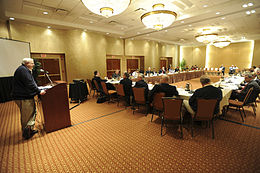
Back إدارة عامة Arabic Alministración pública AST Vėišāsis valdims BAT-SMG Bestir umum BEW Публична администрация Bulgarian पब्लिक एडमिनिस्ट्रेशन Bihari লোকপ্রশাসন Bengali/Bangla Administració pública Catalan Veřejná správa Czech Offentlig forvaltning Danish
| Part of the Politics series |
| Politics |
|---|
|
|

Public administration, or public policy and administration refers to "the management of public programs",[1] or the "translation of politics into the reality that citizens see every day",[2] and also to the academic discipline which studies how public policy is created and implemented.
In an academic context, public administration has been described as the study of government decision-making; the analysis of policies and the various inputs that have produced them; and the inputs necessary to produce alternative policies.[3] It is also a subfield of political science where studies of policy processes and the structures, functions, and behavior of public institutions and their relationships with broader society take place. The study and application of public administration is founded on the principle that the proper functioning of an organization or institution relies on effective management.
The mid-twentieth century saw the rise of German sociologist Max Weber's theory of bureaucracy, bringing about a substantive interest in the theoretical aspects of public administration. The 1968 Minnowbrook Conference, which convened at Syracuse University under the leadership of Dwight Waldo, gave rise to the concept of New Public Administration, a pivotal movement within the discipline today.[4]
- ^ Robert and Janet Denhardt, Public Administration: An Action Orientation. 6th Ed. 2009: Thomson Wadsworth, Belmont CA.
- ^ Kettl, Donald and James Fessler. 2009. The Politics of the Administrative Process. Washington D.C.: CQ Press
- ^ Jerome B. McKinney and Lawrence C. Howard. Public Administration: Balancing Power and Accountability. 2nd Ed. 1998: Praeger Publishing, Westport, CT. p. 62
- ^ O'Leary, Rosemary (2011). "Minnowbrook: Tradition, Idea, Spirit, Event, Challenge". Journal of Public Administration Research and Theory. 21 (1): i1 – i6. doi:10.1093/jopart/muq066. Retrieved 2024-02-17.